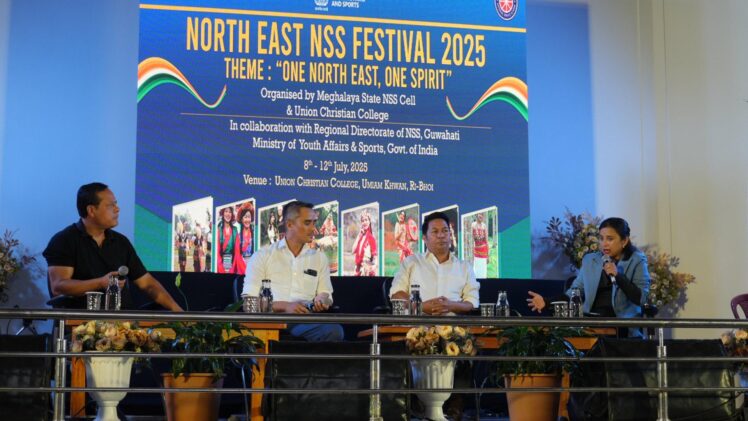
Umiam Khwan | Meghalaya currently holds the highest unemployment rate in the Northeast at 6.0%, according to the Periodic Labour Force Survey (PLFS) 2022–23. In urban areas of the state, the figure jumps to 12.3%, more than double the national urban average of 5.4%.
This statistic is alarming on its own. But in a state where over 74% of the population is under the age of 35, and with thousands graduating each year, it raises critical questions: Where are the jobs? Are young people prepared for them? And are they even aware of the opportunities available to them?
These were some of the pressing issues discussed during a panel session at the North East NSS Festival 2025, hosted at Union Christian College (UCC), Ri Bhoi, where NSS volunteers from across the region gathered for a week long celebration. Moderated by Editor of The 4Front Media – Ibankyntiew Mawrie, the panelists included – Academician Dr Rusievan Shangpliang, Civil Service Officer Eric Kevin Dkhar and Entrepreneur Alan West Kharkongor.
“Educated, but not Employable”
Dr. Rusievan Shangpliang, professor at Synod College, highlighted the ground reality. “You may have a postgraduate degree, but if you don’t have the skills to survive outside, what good is that degree?” he said, questioning the effectiveness of the current education system.
He reflected on years of teaching and wondering what becomes of his former students. “They disappear. We wonder what their situation is. Are they unemployed? Are they waiting for government jobs that never come?”
According to Dr. Shangpliang, the education system is designed to produce conformity, not creativity. “We teach students to memorize and repeat, not to think or listen. That kind of training doesn’t prepare them for life outside.”
Two Versions of the Truth
The state government maintains that Meghalaya’s unemployment rate is 3.9% (as per the state’s official data), creating a disconnect between official data and on-ground realities.
Eric Kevin Dkhar, MCS, the Block Development Officer of Umling Block, acknowledged the conflicting data. “There are two sources: government and PLFS. The numbers differ, and somewhere in between lies the truth,” he said.
But he stressed that while data can be debated, the need for skilling and awareness is clear. “Our youth are smart and educated. We have top notch schools in our state. What they lack is training, and sometimes the information about available opportunities.”
Government Jobs: The Only Option?
Dr. Shangpliang said many students approach him hoping he’ll tell them where to apply for a government job. “To them, job means government job. Anything else, like farming or tourism, doesn’t count.”
This mindset, shaped by years of limited opportunities and corruption in recruitment, is hard to break. “They’ve appeared for exams, waited years for results, only to see undeserving candidates get in. It’s disheartening,” he said.
“Don’t Wait. Create Your Own Job”
Bah Alan West Kharkongor, Director of the Meghalaya Tourism Development Corporation (MTDC), shared a personal example. “I come from a family of eight siblings. Fortunately or unfortunately, I’m the only one without a government job. But today, I employ 30 people.”
He encouraged young people to look at entrepreneurship, tourism, and agribusiness as real career options. “We’re not an industrial state. But we have natural beauty, culture, and resources. We should build on that.”
Kharkongor pointed out programs like YESS Meghalaya, SPARK, and PRIME that are designed to support start-ups and small enterprises. “The opportunity is there; but the youth must be willing to take the first step.”

Students Speak: “We Don’t Even Know These Schemes Exist”
A key moment in the discussion came when a student asked why they didn’t know about any of the schemes meant to help them. “Why is it so hard to access them? Why are the apps so difficult to use?” and that’s the truth, many of these government implemented schemes or apps are not user friendly which leads to general public not benefitting from them.
Bah Eric admitted the gap in communication and promised action. “We rely a lot on social media, but if you don’t know which page to follow, that’s a problem. We’ll work on making information more accessible,” he said.
Rural Shift, Not Urban Flight
Despite fears of rural-to-urban migration, Bah Eric said he hasn’t seen major shifts. “People are staying in their villages. They’re taking up farming, mushroom cultivation, waste management, even eco-tourism,” he said.
Both he and Bah Alan noted a growing trend of reverse migration; where people who once left are now returning to tap into local opportunities.
However, this brings challenges too. “Land conflicts are starting to rise,” Bah Alan said, mentioning more than 20 disputes in areas like Sohra and Wei Sawdong. “When people see value in the land, they come back and that creates new tensions.”
Agriculture: Full of Promise, but Farmers Still Struggle
Agriculture is still central to the state’s economy, but as one student pointed out, farmers rarely get to set the price of their produce. “Middlemen control everything,” he said.
Kharkongor agreed, saying that even prices for state-level produce are often set by outsiders. “We need to empower our farmers. If we don’t, they’ll always be at the mercy of others, even when their produce are selling in other states or countries.”
Dr. Shangpliang added that local produce like oranges and turmeric are sold for high prices in Dubai, while the same remains unaffordable for locals. “There’s too little government intervention. That needs to change.”
ALSO WATCH:
Time to Rethink Education and Opportunity
The panel concluded by emphasizing the need for systemic change.
“We need education that teaches purpose and builds skills, not just theory,” Dr. Shangpliang said. “Vocational training should start from school. If we really want to tackle unemployment, we have to start early.”
He also left the students with a reality check: “When you finish your studies, it’s you alone who’ll apply for the job. Not your friends on social media,” encouraging them to not depend on others.
With Meghalaya’s youth population being one of its biggest assets, there is a need for a reminder that while talent is in no short supply, support, access, and reform are urgently needed.
Until then, the question many young people are asking remains the same: “Where are the jobs?”






